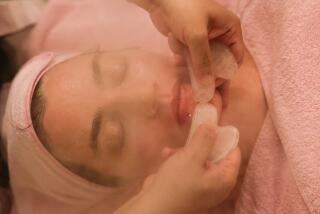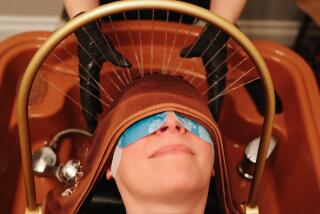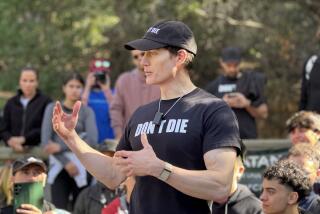Health product claims overshoot the runway of reason
- Share via
It’s frighteningly easy to drop a couple of hundred dollars on a holiday present. If you’re considering spending big money on a health-related gift, you’ll want to make sure that it will do something besides take up space in the gift bag.
Unfortunately, when it comes to health products, even an outsized price tag won’t guarantee results. While some gadgets and devices really do deliver on their promises, others seem to owe their entire existence to wishful thinking and clever marketing.
To see marketing at its finest, simply browse through SkyMall, the airline catalog that aims to connect frequent fliers with all sorts of pricy items, including quite a few products that supposedly revitalize body and mind. The pictures and ad copy make every health gadget seem like a medical breakthrough that would surely be a can’t-miss gift.
One particularly intriguing ad trumpets Aculife Therapist Deluxe, a do-it-yourself acupuncture device from Ireland that uses magnetic pulses instead of needles. Unlike traditional acupuncture treatments that cover much of the body, Aculife is supposed to work only on the hand. The ad includes a map of the hand showing exactly where you need to place the device to reach different parts of the body. The pathway to the stomach, for instance, lies at the center of the palm, a little below the target for the heart. The spot for the prostate lies near the pulse point, a few centimeters away from the spot for the uterus. The device sells on SkyMall for about $200, although you’ll pay slightly less if you order directly from the company website.
If you have any germaphobes on your gift list, you might be tempted by the Nano-UV Wand, something like a lightsaber against microbes. The SkyMall ad shows the glowing device being waved over a head of lettuce, some chopped celery and a few tomatoes. The wand, 22 inches long and 1.5 inches wide, emits two wavelengths of UV light, UV-A and UV-C. Users are instructed to shine the light on any surface they wish to decontaminate for at least 10 seconds. It costs about $100.
If you’re brave enough to give that special someone a beautifying product, you might be intrigued by the Baby Quasar, a hand-held LED device that supposedly uses red, amber and infrared light to rejuvenate the skin. (Sure enough, the young woman in the SkyMall ad doesn’t seem to have a single wrinkle.) The company website instructs users to press the device against each of six zones of the face for two minutes at a time. After each zone is covered, users are supposed to repeat the process. The site recommends completing this routine every other day. The Baby Quasar costs about $400.
The claims
According to the SkyMall ad, Aculife will allow you to “be your own acupuncturist” and will “help strengthen your health with the latest ancient technology.” The ad says that the device will help stimulate “qi,” an internal force that plays a major role in traditional Chinese medicine.
When asked to explain the benefits of the product, a representative of Aculife Ireland said the American version of the company website was one of “the best sources of information.” According to the site, the device can be used to treat an amazing array of ailments, including swollen ankles, back pain, malaria, Parkinson’s disease, hypertension and uterine polyps, just for starters.
The SkyMall ad for the Nano UV-Wand claims that the device “kills 99.99% of bacteria and viruses in 10 seconds.” It goes on to say that users can “stop the spread of infectious diseases — from the common cold and flu viruses to deadly E. coli and Asian bird flu.”
Zlatko Zadro, president of Zadro Products, the company behind the Nano-UV wand, says that independent laboratory tests show that the product really works. Standard washing will remove dirt from fruits and vegetables, he says, but it takes UV light to kill germs. Zadro claims that the combination of UV-A and UV-C light gives the Nano-UV wand extra germ-fighting power. “It’s the most effective product on the market,” he says.
The SkyMall ad for the Baby Quasar calls it a “revolutionary anti-aging device” that will “effectively stimulate the production of collagen and help reverse the signs of aging.” The Baby Quasar website claims that the product can treat acne, rosacea, age spots, fine lines, enlarged pores and “translucent skin,” among other problems.
Alex Webster, vice president of marketing and sales for Baby Quasar, says that users can expect firmer and tighter skin within four to six weeks. According to Webster, the company has had great feedback from women who were thrilled with their results.
The bottom line
In the holiday season — or any time, really — it’s important to remember that not every health gadget actually lives up to the ad copy. The Aculife Therapist Deluxe is one example of a device that seems more fanciful than practical, says Dr. Richard Glickman-Simon, an associate professor of medicine at Tufts University School of Medicine in Boston. Glickman-Simon is also the chair of the department of Western biomedicine at the New England School of Acupuncture in Newton, Mass.
Glickman-Simon says that, while carefully applied acupuncture with needles has some potential to ease pain and relieve stress, there’s no reason to believe that small magnetic pulses would have the same effect. He adds that no reputable practitioner would claim to treat all of the ailments that supposedly respond to the Aculife. “There has never been a panacea in the history of medicine, and there never will be.”
And while acupuncture can sometimes affect parts of the body far away from the needle site, Glickman-Simon says the claim that acupuncture in the hand can treat every part of the body has no basis in either traditional Chinese medicine or modern science. If anyone feels better after using the Aculife, he says, it’s almost certainly because they expected to feel better — the placebo effect in action. At $200, he adds, that’s a very expensive placebo.
The Nano-UV wand at least passes the basic plausibility test, says Kalmia Kniel, associate professor of food parasitology and virology at the University of Delaware in Newark. Kniel co-authored a 2008 study showing that UV-C light could kill hepatitis A and other viruses on lettuce, green onions and strawberries.
Although the Nano-UV wand would undoubtedly kill some germs on foods, Kniel says that it would be extremely difficult to reach every nook and cranny where germs can hide. Exposing every square inch of a salad to UV would be a laborious, time-consuming project, she says. The SkyMall ad shows a person waving a wand over a lettuce head, but Zadro concedes that you’d have to pull out every leaf and lie them flat to really get at the germs.
Kniel believes that the Nano-UV wand may be somewhat more useful for killing bacteria and viruses on a cutting board or other flat surface, but she also cautions that any nicks or cuts could give germs cover. And while it might only take 10 seconds to sanitize a strip of countertop directly under the light, she says it would take much longer to do an entire kitchen. Unless it’s used with great care, the Nano-UV wand could create a false security, she says. “I wouldn’t want people to think that they don’t need to wash their vegetables because they are using this.”
The Baby Quasar is almost certain to disappoint anyone looking for more youthful skin, says Dr. Peter Rubin, a former director of Oculoplastic and Orbital Surgery at Harvard Medical School who now runs plastic surgery practices in both Massachusetts and Florida.
Rubin and colleagues at Harvard recently studied the rejuvenating potential of the Gentle Wave, a powerful LED device offered in some doctors’ offices. While the Baby Quasar probably shines about as bright as a good LED flashlight, Rubin says, the Gentle Wave is more like a traffic signal. The Gentle Wave device is also about 100 times more expensive.
In Rubin’s study, even this highly souped-up version of LED therapy failed to produce any real results. Women receiving the Gentle Wave treatment once a week for eight weeks felt that their skin looked better, but as reported in a 2009 issue of the journal Dermatological Surgery, doctors examining before-and-after photographs couldn’t see any difference. If such a powerful treatment in a doctor’s office fell short, Rubin doesn’t see much hope for the Baby Quasar. For one thing, he says, he doesn’t know of any scientific evidence that low-intensity light can promote collagen.
“The website makes a lot of scientific claims,” he says. “But as a scientist and a doctor, I don’t see anything to it. It’s pseudoscience.”
Curious about a consumer health product? Send an e-mail to [email protected]. Read more at latimes.com/skeptic.


